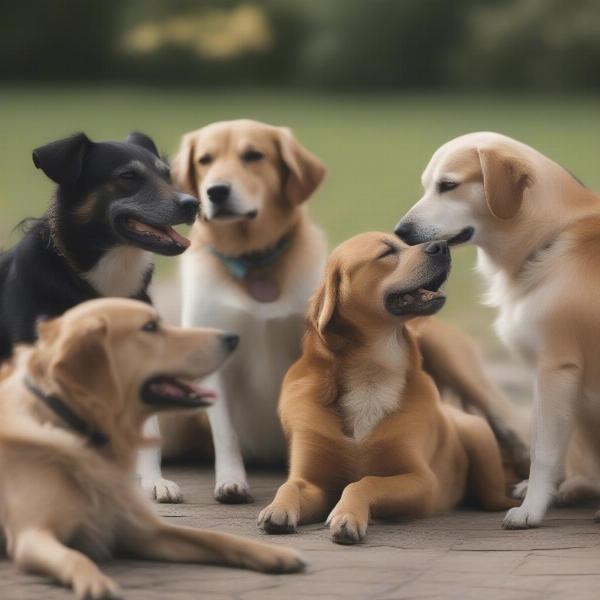The term “dog pack” often conjures images of wolves hunting in coordinated groups, and while dogs share ancestry with these wild canids, the concept of a dog pack in a domestic setting is quite different. Understanding the dog pack hierarchy, dynamics, and social structure is crucial for effective training, behavior management, and building a harmonious relationship with your canine companion. This article delves into the nuances of the dog pack, dispelling common myths and providing practical insights into how dogs interact within a family unit.
Domestic dogs don’t form packs in the same way wolves do. While wolves have a rigid social structure with a clear alpha, domestic dogs are more flexible and adaptable. Their social groups, whether with other dogs or their human families, are more fluid and less hierarchical. The idea of an “alpha dog” dominating through aggression is outdated and often misinterpreted. Leadership in a dog pack, or rather, a dog-human family, is about providing structure, consistency, and guidance, not about asserting dominance. This approach fosters a positive and cooperative relationship based on mutual respect and understanding.
Decoding Dog Pack Dynamics
Within a multi-dog household, dogs will naturally establish a social order. This isn’t a strict hierarchy like in wolves but rather a loose set of preferences and relationships that evolve over time. These relationships are influenced by factors like age, personality, and individual experiences. You might notice one dog initiating play more often or another deferring to a specific dog during mealtimes. These subtle cues reveal the dynamics at play within your own “dog pack.”
 Dog Pack Interaction
Dog Pack Interaction
Understanding these dynamics can help you prevent conflicts and ensure a harmonious environment. For example, providing separate feeding areas can minimize competition and tension during mealtimes. Recognizing which dog is more playful or submissive can help you tailor your interactions and training methods to each individual’s personality.
Your Role in the “Pack”: Leading with Kindness
In a dog-human family, you and your family members are part of the dog’s social group. Your dog looks to you for guidance and security, much like a wolf pup looks to the adults in its pack. This doesn’t mean you need to be the “alpha” in a traditional, dominance-based sense. Instead, it means providing clear rules, consistent boundaries, and positive reinforcement.
Think of it like this: you are the provider of resources, the protector, and the teacher. You decide when it’s time for walks, meals, and playtime. You provide a safe and enriching environment. And you teach your dog the appropriate behaviors through positive reinforcement and consistent training. This leadership style fosters trust and cooperation, creating a strong bond with your canine companion.
Common Misconceptions About Dog Packs
The popularized notion of the “alpha roll” is a prime example of a misinterpreted dog behavior. This practice, involving forcing a dog onto its back, is not a natural way to establish leadership and can be harmful, causing fear and anxiety. Kindness, not dominance, is the key to building a strong relationship with your dog.
Another common misconception is that dogs constantly strive for dominance over their human family members. In reality, most dog behaviors that are interpreted as dominance are simply attempts to communicate needs or respond to environmental stimuli. Understanding your dog’s body language and communication signals is crucial for effective communication and preventing misunderstandings.
Conclusion
Understanding the dog pack isn’t about dominating your dog but about building a harmonious relationship based on mutual respect and understanding. By providing clear rules, consistent boundaries, and positive reinforcement, you can establish yourself as a trusted leader and guide. Remember, kindness and clear communication are the foundation of a strong bond with your canine companion. Discard outdated notions of dominance and embrace a positive approach to build a happy and fulfilling partnership with your furry friend.
FAQ
- Do dogs see their human families as a pack? Yes, dogs integrate their human families into their social group. They look to their human companions for guidance, security, and resources.
- How do I establish myself as the “leader” of my dog’s pack? Provide structure, consistent rules, and positive reinforcement. Focus on guiding your dog, not dominating them.
- Is it necessary to establish dominance over my dog? No, dominance-based training is outdated and often counterproductive. Focus on building a positive relationship based on trust and cooperation.
- How do I prevent pack-related aggression in multi-dog households? Provide separate resources, manage interactions, and consult with a professional dog trainer if necessary.
- What are some signs of a healthy dog pack dynamic within a family? Dogs interact peacefully, share resources without conflict, and defer to each other in certain situations.
- Is the “alpha roll” an effective training method? No, it is harmful and can cause fear and anxiety.
- How can I learn more about dog communication and behavior? Consult with a certified dog trainer or behaviorist, read reputable books and articles, and observe your dog’s body language.
ILM Dog is a leading international website dedicated to providing expert advice and resources on all aspects of dog care and ownership. From breed selection and puppy care to senior dog health and training, we offer comprehensive information to help you navigate the joys and challenges of dog ownership. We specialize in breed selection, health and medical care, training and behavior, nutrition, grooming, and products and accessories. Contact us today for expert advice and guidance. Email: [email protected] Phone: +44 20-3965-8624. ILM Dog is here to support you and your furry friend every step of the way.